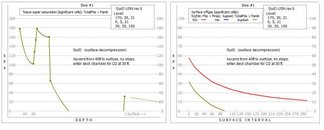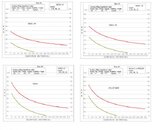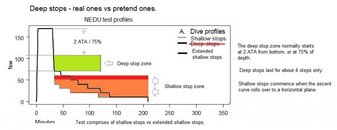Ross, the answer is there.... right in your own graphs. The graphs are flawed in that unlike Kevin's heat maps they don't clearly demonstrate what is happening after surfacing (probably the most important period of supersaturation in slower tissues) and they don't clearly distinguish tissues, but they nevertheless illustrate the important principles. They show that the NEDU deep stops profile (A2) did reduce supersaturation in the faster tissues early in the ascent. But even with the post-surfacing data cut off (why did you do that Ross?) it is actually clear (from your own graphs and contrary to your "it ain't there" claim above) that there is greater supersaturation in in the slower tissues later in the ascent. If protecting fast tissues from supersaturation early in the ascent is so critical to decompression efficacy (as fundamentally assumed by bubble models) why did the profile that achieved that result in most DCS? The answer is that the problems are arising from slower tissues exposed to more sustained supersaturation later in the ascent (as shown in your own graphs).
Simon M
Spare a thought for Commercial and Military divers doing Surface Decompression on this 170ft, 30 min dive: (ascend from 40 ft to surface - no stops, complete the deco on O2 in deck chamber). Here is their supersaturation:

All dive planning is a compromise. Here the SurD procedure is to accept an intolerable supersaturation pressure, for a few minutes, and then correct for that with an abundance of 100% O2 deco. Its an aggressive deco where larger volumes of gas are moved around quickly. Consequently the surface period has rather low supersaturation. This deco works because it's a balance between bad and not so bad factors.
ZHL is a balance between bad and not so bad factors. It has a higher supersaturation to begin with and a modest amount to end with. Consequently its surface period supersaturation can be higher than the SurD process, because the ZHL deco method shifted some of the overall stress out the dive and onto the surface period.
VPM is a balance between bad and not so bad factors. It has lower supersaturation across the whole ascent, and keeps it almost constant throughout, and finishes at the same place as ZHL does. VPM's surface period supersaturation can be higher than the SurD process, and higher than ZHL model because VPM shifted some more of the overall stress out the dive and onto the surface period.
All three procedures work, because they are a balanced compromise between conflicting bad factors. One compromise is no better than the next one. These ideas that one deco is more "efficient" than the next, is misguided.
Our surface supersaturation graphs are perfectly good, and show the important details only - that's the part where off gassing occurs. They show sustained maximum pressures. A scientist might find that of interest too.
The heat maps you refer are colorful eye candy only, that are absent pertinent details. But I can understand the appeal of those flashy marketing materials to trick the pubic into a false belief.
*****
Here is the surface off gas charts that you requested. The Nedu dives, and a VPM-B and a GF 60/85 dive.

Notice how the A1 and A2 dives are well below normal dive levels. That's because the deco was stretched double length. Notice how your "increased integral of supersaturation and time", is not there either.
On the subject of "integral of supersaturation and time" Before you completely shoot your foot off, consider this: A decompression dive that misses all stops, and blasts to the surface for an agonizing death from DCS on the boat deck, this diver will have a low "integral of supersaturation" value. That goes for both in dive and post dive. But he will have some awful big, supersaturation generated, bubbles clogging up the plumbing.
Conversely, a dive that follows the slowest possible ascent rate at the ambient pressure line (GF 0), will have an extremely large "integral of supersaturation and time" value.
Low is bad, high is good. It's an inverse measure. That's the problem when you just "make stuff up" Simon. The way you guys add up 16 concurrent values is flawed, and it includes harmless levels of surface off gassing. This "integral of supersaturation" is worthless as a measure, and in any case, it demonstrates VPM to be the safer approach. But then, I'm more intelligent that to get suckered into this "integral of supersaturation and time" nonsense.
***********
ZHL and VPM both use the Haldane and Schriener equations to track gas pressures (as do many other models). These formula will track concurrently the on gassing, and off gassing, at any point in the dive, including ascent and deco. In any dive from any model, the ascents and deco stops will be both on gassing, and off gassing at different ends of the cell table.
Shallow stop models on gas in deco, deep stop models on gas in deco, multilevel ascent on gas, and extending shallow stop on gas too. They all on gas in deco and ascent. The equations handle this normally, and every deco model recomputes its ascent at each step. The gas tracking calculation in use today of current gas pressures values seems to be correct.
But you keep trying to imply it's not working, or insufficient. So kindly stop dancing around and get to the point. Tell us what is wrong with the Haldane / Schriener equations, and how you propose to change that?
These test profiles should have been fantastically safe by ZHL / GF standards.
And how would you know that Ross? Where is your database of carefully standardized ZHL / GF air dives to 170' for 30 minutes with air decompression, ....
Simon M
Did you forget, or just pretending to forget?
There is the DCIEM tables. These were created by Canadian DRDC, including VGE correlations, and man tested, with known pDCS risks. The DCIEM tables are widely approved for commercial and government work. This DCIEM table prescribes a deco time of 77 minutes, vs the 174 of the nedu test. The nedu test is 2.25 times longer than needed. The astute scientist would see the anomaly of the nedu test results, and realize it's out of context with the bigger picture.
More simply, all you need to do is apply the "plain obvious" test. The nedu profiles took normal profile and extended them out 2x longer in the shallow zone. Never mind all the fantasy descriptions and USN dive politics in this - these are two shallow stop dive profiles.
It's the same process that is applied by millions of divers, and recommended by anyone in deco medicine - to make it safer, make it longer in the shallow part. And that's what the nedu test did.
Which brings us to the conundrum you face. Your suggested fix for this, is to go more shallow, and go longer in deco... towards the higher risk A2 profile attributes.





